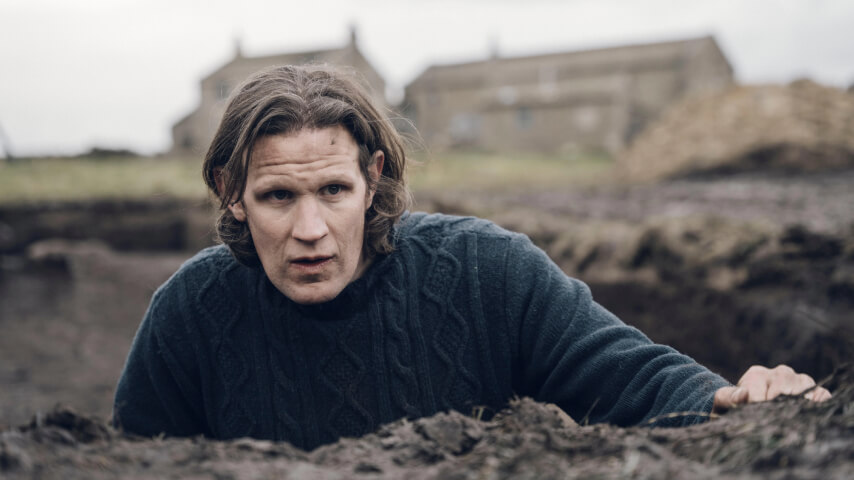Evil takes root in the traditionally slow-burn folk horror Starve Acre
Matt Smith and Morfydd Clark are stuck in a cottagecore nightmare on Starve Acre
Photo: Chris Harris
Despite the whirlwind tragedy of its opening act, Starve Acre is not rushing to get anywhere. With his second feature, writer-director Daniel Kokotajlo wants us to breathe in as much of Starve Acre’s rancid air as our lungs can tolerate. Capturing the English countryside’s ethereal black magic with patience and awe, the movie isn’t concerned with uprooting folk-horror traditions. It wants to get them right. Aiming for authenticity, Kokotajlo finds supernatural power and dramatic weight in the genre’s rustic simplicity.
Starve Acre’s power is in its verisimilitude. Even the 2019 novel it’s based on was originally published as part of a collection of purportedly “lost” British horror classics. Likewise, Kokotajlo’s adaptation wouldn’t be out of place on a double feature with The Blood On Satan’s Claws. But its grainy photography and creeping camera would be nothing without a story that works in its favor. Even as it tends to convention, Starve Acre finds its own rhythms, ideas, and terrors, offering a haunted portrait of a parent’s worst nightmare.
After his parents die, Richard (Matt Smith) inherits his childhood home at Starve Acre and moves his wife, Juliette (Morfydd Clark), and son, Owen (Arthur Shaw), to this idyllic patch of land in Northern England. One year into life in the country, the cottagecore dream abruptly ends. Owen isn’t adjusting well. He hears the whistling of “Jack Grey,” the chief character in local pagan rituals that Richard’s father obsessed over. Soon, the voices give way to violence, and before his parents can call an exorcist, Owen succumbs to an asthma attack with Juliette right by his side, seemingly lost in a trance.
Kokotajlo frontloads the film with incident, but things slow down considerably after Owen’s death. Sinking deeper into grief, Smith relentlessly hides from Clark and the camera—his chin firmly affixed to his chest. Over the last few years, Smith has shed his Doctor Who heroics for a spectrum of villain roles. But in the Yorkshire Dales, he ditches the flamboyance of Morbius and “Grrr, baby, very grrr” of Last Night In Soho for a quieter menace. Clark, too, retreats into herself, finding an anti-Galadriel character, one drained of her power. Her meek stature is a perfect foil for Smith, who spends the film crouching around Starve Acre’s tight quarters as they avoid each other’s glances.
The script leaves a trail of breadcrumbs through the film, delicately revealing the folklore’s depth. Stuck in the pre-internet ‘70s, Richard and Juliette tumble down their homestead’s actual rabbit holes, discovering the primordial black magic of Starve Acre and, appropriately, a hare. Led by a kindly farmhand, Gordon (Sean Gilder), and his wife and amateur mystic, Mrs. Forde (Melanie Kilburn), Richard and Juliette excavate Starve Acre’s history and mysteries. Like the families in Hereditary and Rosemary’s Baby, the couple tiptoes toward a cosmically nihilistic conclusion more inevitable than predictable.
While the film stays rooted in genre, Starve Acre isn’t stuck in the past. Cinematographer Adam Scarth’s super-wide landscapes capture a foreboding sense of helplessness and isolation—he slowly zooms into the Dales as white fog swallows the valley—that reflect the COVID turmoil of the last half-decade. Like many during the pandemic, Richard and, especially, Juliette spiral deeper down their rabbit holes, turning away from traditional science and religion and finding alternative answers to quell their anxiety. On a paranoid binge that would make QAnon’s most faithful queasy, Richard and Juliette grow more suspicious of the world around them as they cut themselves off from their loved ones. In his grief, Richard begins digging into Starve Acre’s history, literally, and seeks out the stump of a great, cursed oak tree buried on the property by witch-hunting villagers centuries ago. Juliette, a yogi who considers herself slightly woo-woo, joins a séance to talk to Owen, which goes about as well as one would expect. If only these two knew they were in a horror movie. When Juliette’s worried sister, Harrie (Erin Richards), checks on the couple, she discovers a homestead on the brink. Juliette’s alienation and Richard’s obsession evoke that all-too-familiar feeling of watching a loved one fall for a conspiracy theory.
Though Starve Acre finds these pathways to relevancy, it walks them with a lumbering gait. There’s confidence and casualness in how its drama unfolds, though this can wear on the viewer, especially those hoping for significant revelations at every turn. Being a folk horror traditionalist has its drawbacks, and Starve Acre inherits the ponderous pace that’s part and parcel with the genre it’s recreating. Depending on one’s tolerance for landscape shots, natural lighting, and digging in the mud, the movie’s patience might test the viewer’s. Still, Starve Acre believes in its myths and finds an explosive payoff to its slow burn. Harvesting one of the strangest final images of the year, the movie reaps what it sows.
Director: Daniel Kokotajlo
Writer: Daniel Kokotajlo
Starring: Matt Smith, Morfydd Clark
Release Date: July 26, 2024